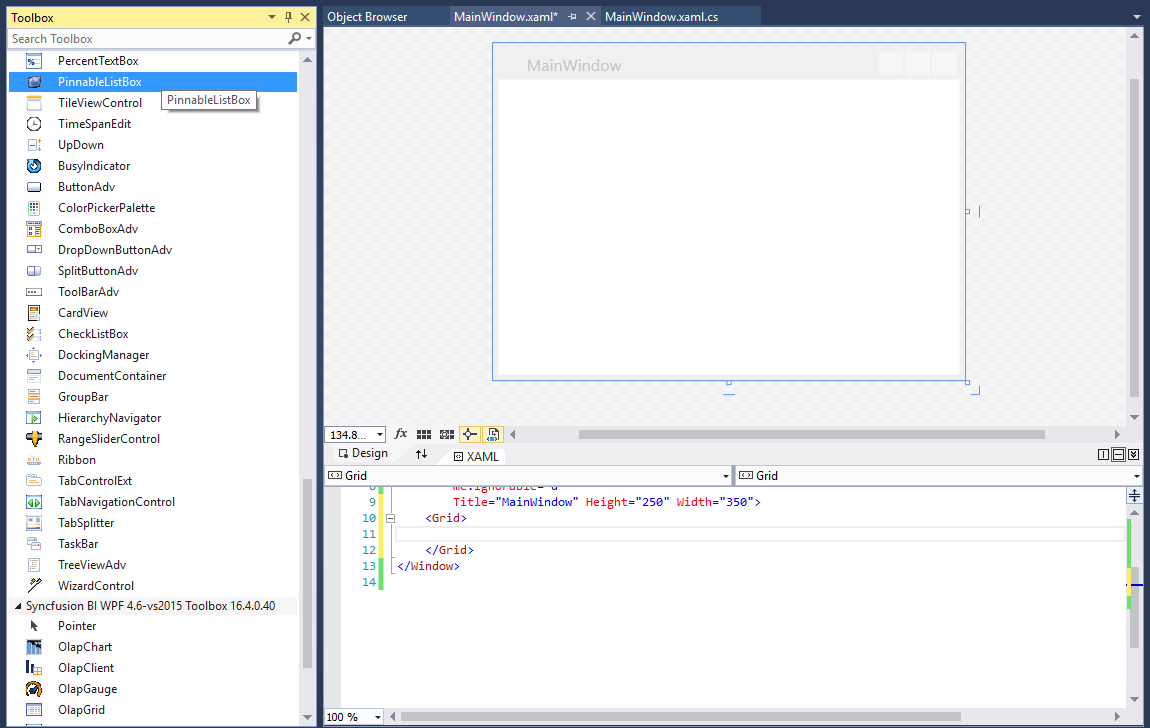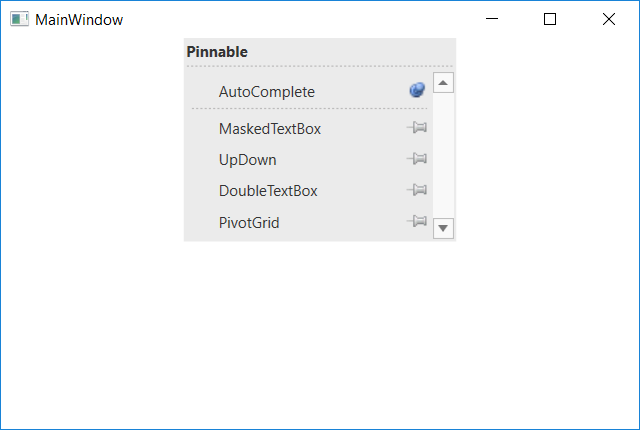Getting Started with WPF PinnableListBox
18 Feb 20255 minutes to read
Assembly deployment
Refer to the control dependencies section to get the list of assemblies or NuGet package that needs to be added as a reference to use the control in any application.
You can find more details about installing the NuGet package in a WPF application in the following link:
Create a simple application with PinnableListBox
You can create a WPF application with the PinnableListBox control using the following steps:
Create a project
Create a new WPF project in Visual Studio to display the PinnableListBox with functionalities.
Add control through designer
The PinnableListBox control can be added to an application by dragging it from the toolbox to a designer view. The Syncfusion.Shared.WPF assembly reference will be added automatically to the project.

Add control manually in XAML
To add the control manually in XAML, follow the given steps:
- Add the Syncfusion.Shared.WPF assembly reference to the project.
- Import Syncfusion® WPF schema http://schemas.syncfusion.com/wpf in the XAML page.
- Declare the PinnableListBox control in the XAML page.
<Window xmlns="http://schemas.microsoft.com/winfx/2006/xaml/presentation"
xmlns:x="http://schemas.microsoft.com/winfx/2006/xaml"
xmlns:syncfusion="http://schemas.syncfusion.com/wpf"
x:Class="PinnableListBoxSample.MainWindow"
Title="PinnableListBox Sample" Height="350" Width="525">
<Grid>
<!-- Adding PinnableListBox control -->
<syncfusion:PinnableListBox x:Name="pinnableListBox" HorizontalAlignment="Center" VerticalAlignment="Center" Width="100"/>
</Grid>
</Window>Add control manually in C#
To add the control manually in C#, follow the given steps:
- Add the Syncfusion.Shared.WPF assembly reference to the project.
- Import the PinnableListBox namespace using Syncfusion.Windows.Shared;.
- Create a PinnableListBox instance, and add it to the window.
using Syncfusion.Windows.Shared;
namespace PinnableListBoxSample
{
/// <summary>
/// Interaction logic for MainWindow.xaml
/// </summary>
public partial class MainWindow : Window
{
public MainWindow()
{
InitializeComponent();
//Creating an instance of PinnableListBox control
PinnableListBox pinnableListBox = new PinnableListBox();
//Adding PinnableListBox as window content
this.Content = pinnableListBox;
}
}
}Add items using PinnableListBoxItem
You can add the items inside the PinnableListBox control using PinnableListBoxItem.
<syncfusion:PinnableListBox x:Name="pinnableListBox" Height="200" Width="200">
<syncfusion:PinnableListBoxItem Content="PivotGrid"/>
<syncfusion:PinnableListBoxItem Content="DoubleTextBox"/>
<syncfusion:PinnableListBoxItem Content="UpDown"/>
<syncfusion:PinnableListBoxItem Content="MaskedTextBox"/>
<syncfusion:PinnableListBoxItem Content="AutoComplete"/>
</syncfusion:PinnableListBox>pinnableListBox.Items.Add(new PinnableListBoxItem() { Content = "PivotGrid" });
pinnableListBox.Items.Add(new PinnableListBoxItem() { Content = "DoubleTextBox" });
pinnableListBox.Items.Add(new PinnableListBoxItem() { Content = "UpDown" });
pinnableListBox.Items.Add(new PinnableListBoxItem() { Content = "MaskedTextBox" });
pinnableListBox.Items.Add(new PinnableListBoxItem() { Content = "AutoComplete" });Bind data
You can populate the PinnableListBox control using the ItemsSource property.
- Model.cs
public class Model
{
public string Header
{
get;
set;
}
}- ViewModel.cs
public class ViewModel
{
private ObservableCollection<Model> pinItems;
public ObservableCollection<Model> PinItems
{
get { return pinItems; }
set { pinItems = value; }
}
public ViewModel()
{
PinItems = new ObservableCollection<Model>();
populateItems();
}
private void populateItems()
{
PinItems.Add(new Model() { Header = "DoubleTextBox" });
PinItems.Add(new Model() { Header = "UpDown" });
PinItems.Add(new Model() { Header = "AutoComplete" });
PinItems.Add(new Model() { Header = "PivotGrid" });
PinItems.Add(new Model() { Header = "MaskedTextBox" });
}
}- MainWindow.Xaml
<syncfusion:PinnableListBox DisplayMemberPath="Header" ItemsSource="{Binding pinItems}" Width="200"/>